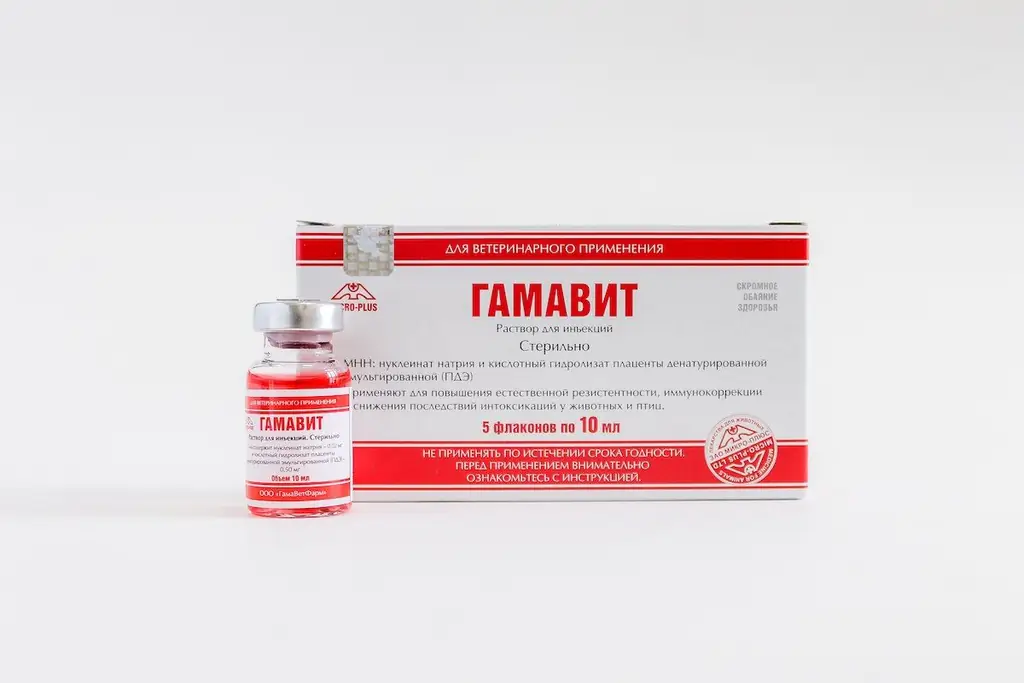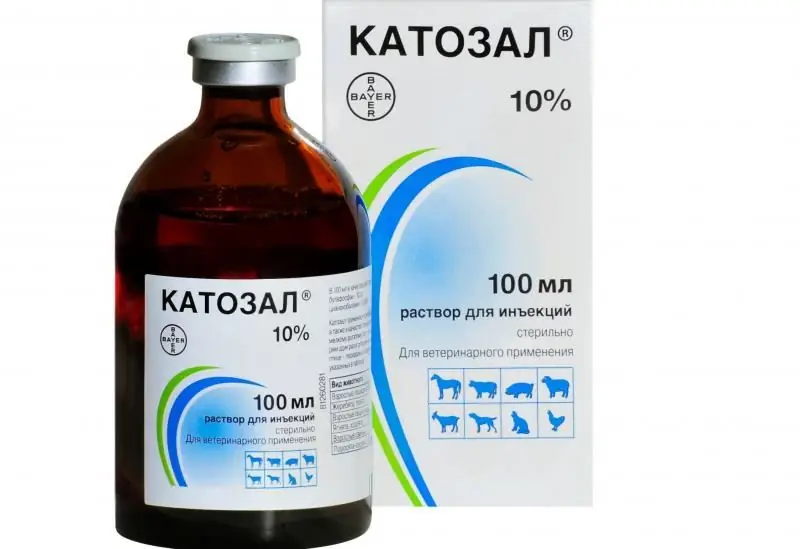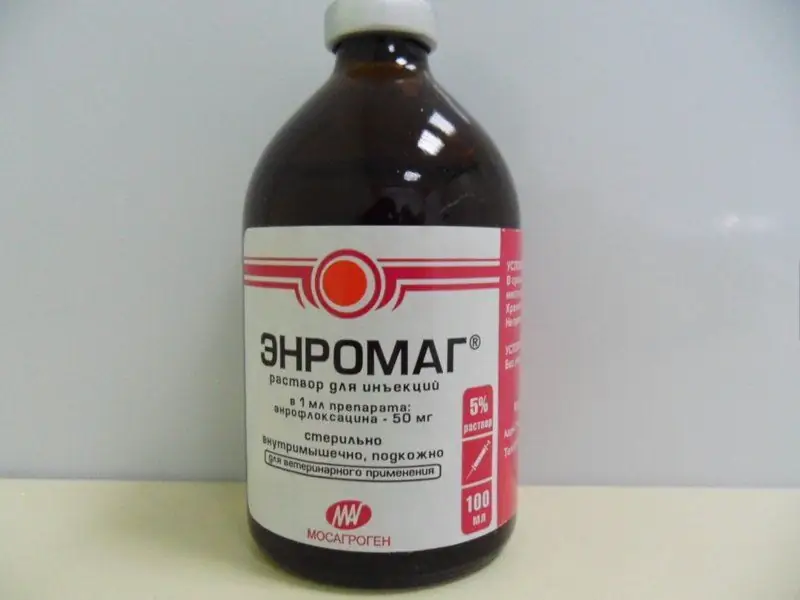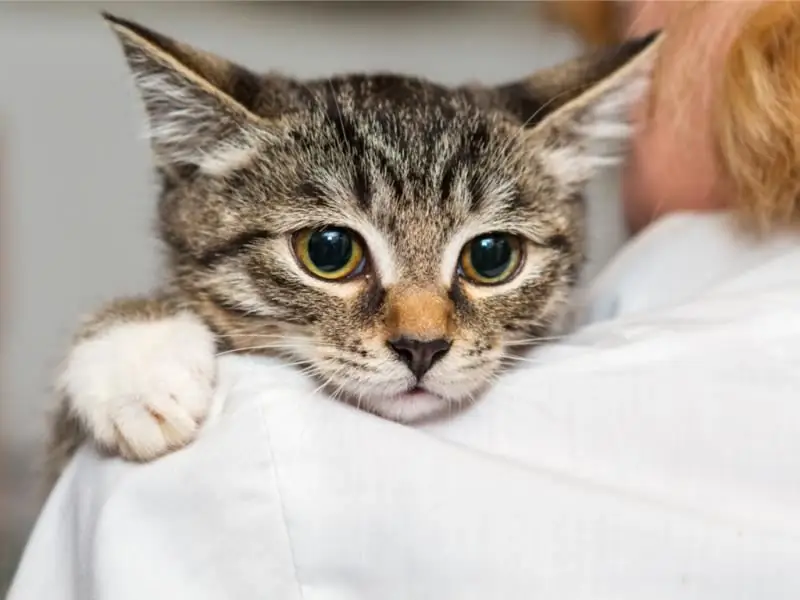
Table of contents:
- Antibacterial drug Tylosin for the treatment of cats
- Composition and release form of the drug Tylosin
- The mechanism of action of the drug
- Indications for use
- How to use Tylosin correctly
- Storage conditions and shelf life
- Table: an overview of the main characteristics of the drug Tylosin and its analogues
- Reviews of the drug owners of cats and veterinarians
- Author Bailey Albertson [email protected].
- Public 2023-12-17 12:53.
- Last modified 2025-06-01 07:32.
Antibacterial drug Tylosin for the treatment of cats

Macrolides are a group of antibacterial drugs that are widely used in veterinary medicine both because of their high efficiency and wide spectrum of action, and due to the high safety inherent in all members of this group. One of the widely used and prescribed macrolides is Tylosin. It was first isolated from a mushroom culture in 1955, and an antibacterial agent based on it was created exclusively for the treatment of animals and takes into account the peculiarities of their physiology.
Content
- 1 Composition and release form of the drug Tylosin
- 2 The mechanism of action of the drug
- 3 Indications for use
-
4 How to use Tylosin correctly
- 4.1 Video: how to give an injection correctly
- 4.2 Table: calculation of the dose depending on the weight of the cat
- 4.3 Compatibility with other drugs
- 4.4 Features of use in kittens and pregnant cats
- 4.5 Contraindications and side effects
- 5 Storage conditions and shelf life
- 6 Table: an overview of the main characteristics of the drug Tylosin and its analogues
- 7 Reviews of the drug owners of cats and veterinarians
Composition and release form of the drug Tylosin
Tylosin is produced in the form of an optically transparent solution of a slightly viscous consistency of light yellow tint.
When purchasing Tylosin, an additional needle should be purchased for each injection to take the antibiotic from the vial, and, given the viscosity of the drug, the needle should be chosen thicker
Composition of the preparation:
-
active substance - tylosin base:
- Tylosin 50 contains 50 mg in 1 ml;
- Tylosin 200 contains 200 mg in 1 ml;
-
Excipients:
- propanediol;
- benzyl alcohol;
- water for injections.
The drug is poured into glass bottles in volumes of 20, 50 and 100 ml. The rubber cap of each vial, which ensures tightness, is reinforced with an aluminum cap, on top of which there may be an additional plastic cap to facilitate access to the drug. Each bottle is supplied with instructions for the use of Tylosin.

Plastic cap over the cap for easy access to the drug
The mechanism of action of the drug
Tylosin belongs to the macrolide group. Tylosin implements its mechanism of action by binding to the ribosomes of bacterial cells and blocking protein synthesis by them, due to which bacteria lose the ability to multiply, as well as restore their structure, as a result of which they die. Since Tylosin does not directly kill bacteria, its action is defined as bacteriostatic.
Tylosin is active against:
- streptococcal flora;
- staphylococcal flora;
- anthrax bacilli (cats are insensitive to this infection);
- the causative agent of pasteurellosis;
- Haemophilus influenzae;
- leptospira;
- chlamydia;
- spirochetes;
- colibacillus;
- some other microorganisms.
The action of Tylosin develops rapidly, when administered intramuscularly, after 60 minutes, its concentration becomes therapeutic.

Tylosin is available in a wide range of volumes and dosages, which makes it convenient to use
Tylosin reaches the greatest accumulation in:
- kidneys;
- bronchi and lungs;
- mammary glands;
- liver tissues;
- intestines.
The elimination of Tylosin is carried out:
- kidneys - excreted in the urine;
- liver - through bile;
- if a cat is feeding kittens, Tylosin will be found in breast milk.
When assessing the degree of impact on the body, Tylosin, like all macrolides, was recognized as a low-hazard compound.
Indications for use
Registered indications for the use of Tylosin in cats are:
- bronchopneumonia;
- arthritis;
- bacterial dysentery;
- secondary bacterial infection in viral diseases.
In veterinary practice, the range of application of Tylosin is wider and includes eye infections, metroendometritis, purulent infections of the skin and soft tissues, otitis media and many other diseases caused by flora susceptible to Tylosin
How to use Tylosin correctly
Tylosin administration rules:
- injected into the muscle;
-
once a day;

Scheme of sites for intramuscular subcutaneous administration of drugs Tylosin is injected intramuscularly and requires alternating injection sites
- treatment course 5-7 days;
- alternation of injection sites: the drug is not injected repeatedly into the same place.
Video: how to give an injection correctly
Dosing Tylosin, according to his instructions, in cats is carried out:
- 0.1-0.2 ml per kg of body weight for Tylosin 50;
- 0.025-0.05 ml per kg body weight for Tylosin 200.
Tylosin 50 is more acceptable for cats because:
- it is much more convenient to dose it;
- When purchasing Tylosin 200 for the treatment of a cat, you need to understand that after all the torment with dosing the drug, its remainder will have to be thrown away, since the opened bottle is stored for no more than 28 days.
Table: calculation of the dose depending on the weight of the cat
| Weight of a cat, kg | Tylosin 50, ml | Tylosin 200, ml |
| one | 0.1-0.2 | 0.025-0.05 |
| 2 | 0.2-0.4 | 0.05-0.1 |
| 3 | 0.3-0.6 | 0.075-0.15 |
| 4 | 0.4-0.8 | 0.1-0.2 |
| 5 | 0.5-1.0 | 0.125-0.25 |
| 6 | 0.6-1.2 | 0.15-0.3 |
| 7 | 0.7-1.4 | 0.175-0.35 |
| 8 | 0.8-1.6 | 0.2-0.4 |
| nine | 0.9-1.8 | 0.225-0.45 |
| ten | 1.0-2.0 | 0.25-0.5 |
If you skip the next injection of Tylosin, you should resume the previous treatment regimen as soon as possible without changing the dosage. It is very important to adhere to the regimen of antibacterial therapy with Tylosin, since otherwise this can result in both failure to achieve a clinical effect and the formation of resistance (resistance) in a bacterial pathogen due to the occurrence of mutations in its genes. The emergence of cross-resistance is especially dangerous when the bacterium becomes resistant to antibiotics not only of the macrolide group, to which Tylosin belongs, but also to penicillins, cephalosporins, aminoglycosides and other antibacterial agents.
Compatibility with other drugs
Drugs that reduce the therapeutic efficacy of Tylosin and are not prescribed together with it:
- tiamulin;
- clindamycin;
- penicillins;
- cephalosporins;
- chloramphenicol;
- lincomycin.
Features of use in kittens and pregnant cats
There are no age restrictions when treating Tylosin, so its use is permissible when treating kittens. Treatment of pregnant and lactating cats is carried out with caution and only under the supervision of a veterinarian. For the period of treatment of the mother-cat with Tylosin, kittens are transferred to artificial feeding, since Tylosin secreted with mother's milk can cause intestinal dysbiosis in kittens.

When treating a lactating cat with Tylosin, kittens are fed artificially
Contraindications and side effects
The only contraindication is individual hypersensitivity to the components of Tylosin, which can manifest itself:
- the formation of redness and swelling at the injection site of the drug;
- itchy skin;
- hives;
- an attack of suffocation;
- other signs of acute allergies.
Such manifestations require immediate discontinuation of the drug and leaving an appropriate entry in the animal's card, preventing its repeated administration
There are no side effects and complications when using Tylosin, according to its instructions. In case of an overdose of the drug, no symptoms are detected.
Storage conditions and shelf life
Tylosin is stored by:
- at temperature of from 10 to C 25 to about C;
- without access to moisture;
- without access to direct sunlight;
- without the access of children and pets;
- separately with products intended for human and animal nutrition;
- in a tightly closed package.
If these rules are observed, Tylosin is stored for 2 years from the date of production, which is indicated on the package. The drug unused during this period is not subject to further storage and use and is disposed of. An opened vial of Tylosin can be stored for 28 days.
Table: an overview of the main characteristics of the drug Tylosin and its analogues
| A drug | Structure | Release form | Indications | Contraindications | Price, rub |
Manufacturer CJSC Nita-Pharm; Russia |
Tylosin | Solution for intramuscular injection in vials of 20, 50, 100 ml, 50 and 200 mg of tylosin in 1 ml |
|
Individual intolerance to the components of Tylosin | 115 rubles for 50 ml of Tylosin 50 |
| Tilanik. Producer LLC "VIK - Animal Health"; Russia | Tylosin | Solution for intramuscular injection in vials of 10, 50, 100, 200 ml, 50 or 200 mg of tylosin in 1 ml |
|
Individual intolerance to the components of Tilanik | 345 rubles for 100 ml of 20% tylosin solution |
| Pharmazin 50, 200, 500, 1000. Manufacturer Huvepharma; Bulgaria | Tylosin tartrate | Solution for intramuscular injection containing 50, 200, 500, 1000 mg of tylosin in 1 ml in vials of 25, 50, 100 ml |
|
Individual intolerance to the components of Pharmazin | 115 rubles for 50 ml of Farmazin 50 |
| Tylosinavet 200. Manufacturer "Belekotekhnika"; Belarus | Tylosin | Solution for intramuscular injection, containing 200 mg of tylosin in 1 ml in vials of 50, 100, 200, 400, 450, 500 ml |
For the treatment of diseases:
|
|
365 rubles for 100 ml |
Comparing Tylosin preparations, it is worth noting their absolute interchangeability and affordability. The most detailed instruction is from the Belarusian drug Tylosinavet, which is very appealing to its manufacturer. Pharmazin, Tylosin and Tilanik have dosages convenient for use in cats.
Reviews of the drug owners of cats and veterinarians
The drug Tylosin belongs to the group of macrolides and is characterized by high safety and effectiveness in the treatment of arthritis, bronchopneumonia, abscesses and phlegmons of the skin and soft tissues, dysentery, as well as secondary infection with bacterial flora in viral diseases. Tylosin is used to treat chlamydia and mycoplasmosis. It can be used on both kittens and pregnant cats. For the price, the drug is highly available.
Recommended:
Gamavit For Cats: Instructions For Use In Veterinary Medicine, Price, Dosage, Reviews

What is Gamavit used for in cats? What effect it has. Are there any contraindications and side effects? Reviews of veterinarians and cat owners
Ivermek For Cats: Use In Veterinary Medicine, Instructions For The Preparation, Treatment Of Parasites With Ivermectin, Reviews And Analogues

The drug Ivermek, its form of release, their composition. Indications and contraindications. How to apply and store it. Comparison with analogues
Catosal For Cats: Instructions For Use In Veterinary Medicine, Indications And Contraindications, Dosage, Reviews And Analogues

What is the drug Catosal used for in cats? What effect does the product have? Are there any contraindications and side effects? Reviews about the drug
Enromag For Cats: Instructions For Use In Veterinary Medicine, Indications And Contraindications, Side Effects, Reviews, Cost, Analogues

Why is the Enromag remedy used in cats, what effect the remedy has, contraindications and side effects from the use of Enromag. Reviews.
Baytril: Instructions For Use In Veterinary Medicine, Indications For Treatment In Cats, Contraindications, Reviews, Cost And Analogues

What infections is Baytril used against? Mechanism of action and treatment regimen. Contraindications, side effects. Analogs. Reviews of veterinarians and cat owners
